

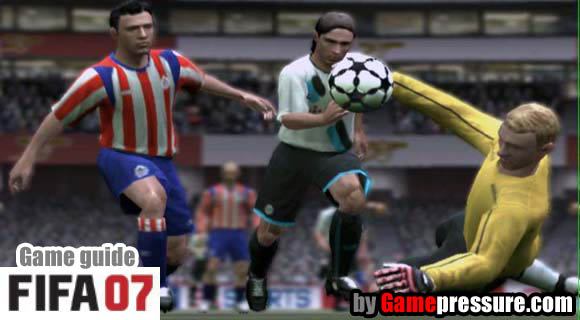
Welcome to the game guide about FIFA 07, the brand new football game made by Electronic Arts. This article is divided into three parts. The first one describes Manager Mode - questions of finances, looking after footballers and trading on the transfer market. Second section concerns on performing and using various manoeuvres on the pitch. The last parts is about tactics that can be used during the game.
This game guide has been prepared especially for those, who didn't play any FIFA game at all. Those, who have seen previous EA football productions, can start playing FIFA 07 without any extra hints.
Enjoy. Hope you'll score high and find generous sponsors.
Manager Mode is the most important one and it needs a thorough description. In this part of the game guide, you'll find information about transfer market, club's finances, choosing sponsors and training players.
In the beginning, we have to create a new manager. Let's fill all the gaps, choose appearance and currency (have no fear - it is possible to change the currency later, if necessary).
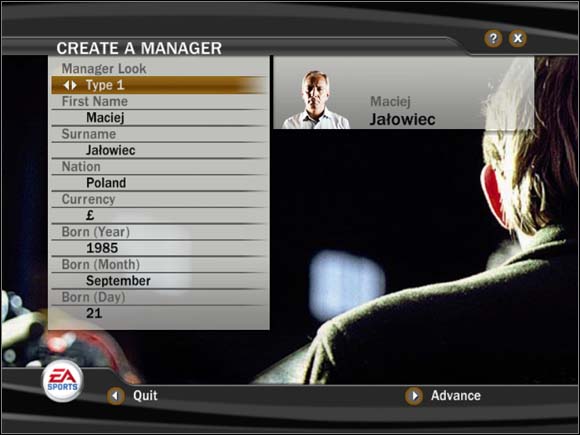
Now, let's choose where we want to work. Select the country and take a look if there's Yes next to Job(s) Available. If it is, that means that somebody in this region is looking for a guy like you (how sweet...)! Press Select to go to next section.
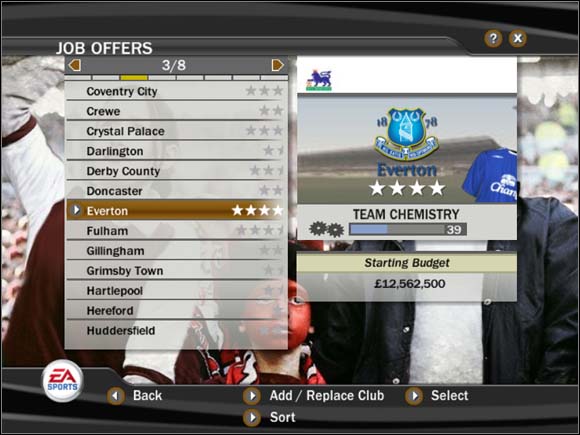
Now, we must choose a club. Amount of teams depends on the region that we're interested in. Besides sympathy, take into consideration the amount of stars, team chemistry, parameters of attack (ATT), middle play (MID) and defence (DEF). In addition, taking a look at the Starting Budget wouldn't be a bad idea.


Stars below the club's logo are a summary estimation of attack, middle play and defence.
After choosing a club, we have to find a sponsor. There's not many of them, let's take a look at the amounts they offer.
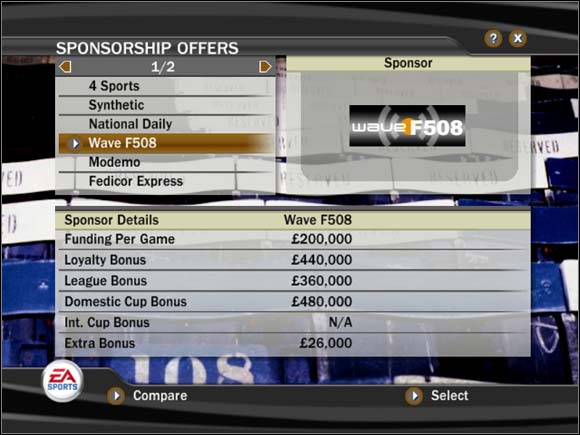
Funding Per Game - cash paid for each match;
Loyalty Bonus - extra money if you sign a contract with the same sponsor in the next season;
League Bonus - money given for winning the league cup;
Domestic Cup Bonus - reward for winning the domestic cup;
Int. Cup Bonus - extra money paid for winning tournaments like Champions League or UEFA Cup;
Extra Bonus - reward for special achievements (clean sheets or, as you can see in the picture below, winning 5 leagues in a row).
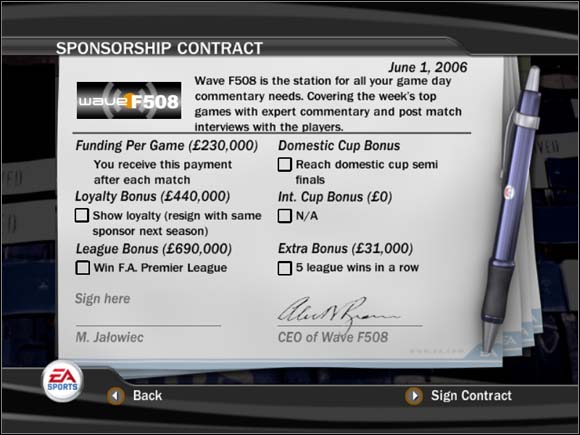
Sometimes sponsor shows generousness by, for example, paying extra 10% for a won match or a clean sheet.
It is not possible to change the sponsor during the season. It is available only when it ends.
Manager Mode main screen
Let's see, what do we have got in the main and first screen we'll see in the Manager Mode.
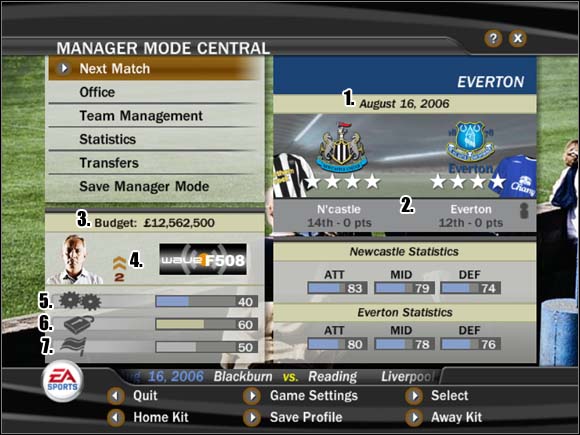
1. Present date;
2. Position in the league cup statistics and amount of points. In the picture, we can see that our team is twelfth and we've got no points. That's because it's the beginning of the season;
3. Club's budget. Check it regularly, especially if you're planning to buy something or someone. For more information about finances, check the Transfers and finances chapter;
4. Manager's mark. Increases with the in-game progress;
5. Team chemistry. Raises during the game, especially if you win. Helps increase team experience. High team chemistry means that players exactly know their roles on the pitch and they need less time to move from defence to attack;
6. Job security. This is how club's management rates your work. It increases with won matches, decreases when your team loses;
7. Fan support. Increases and decreases similarly to job security. Fans' sympathy results in amount of people coming to our matches.
Staff upgrades
Menu Staff Upgrades allows us to upgrade our club. Let's see, what can we do here.
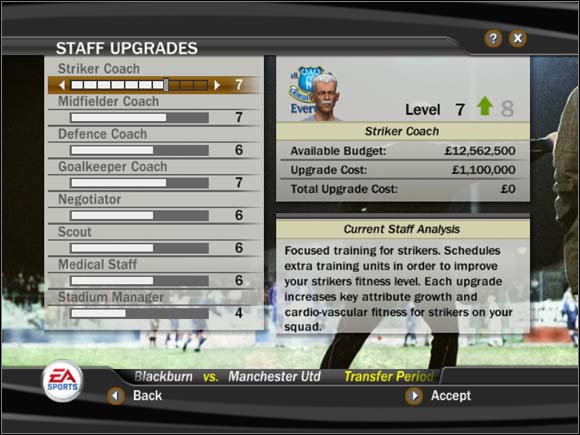
There are 8 ways to improve the club's work. Each one is divided into 10 levels of advancement:
Striker Coach - upgrades strikers' factors;
Midfielder Coach - upgrades midfielders' factors;
Defence Coach - upgrades defenders' factors;
Goalkeeper Coach - upgrades goalkeepers' factors;
Negotiator - this upgrade allows us to buy better players for less money;
Scout - gives more information about players from other clubs and increases scouting efficiency;
Medical Staff - advances players' regeneration after an ordinary tiredness and serious injuries;
Stadium Manager - the most expensive upgrade. Increases number of seats on the stadium, which results in a bigger ticket income.
If you decided to work in a small club, I advise you to invest in Medical Staff and Stadium Manager. Bigger and richer teams may try to hire new coaches, negotiators, etc.
Scouting
There are two ways of acquiring new, young players. The first one is connected with scouting. If we want to send a scout in order to find a player, we must specify a few things.
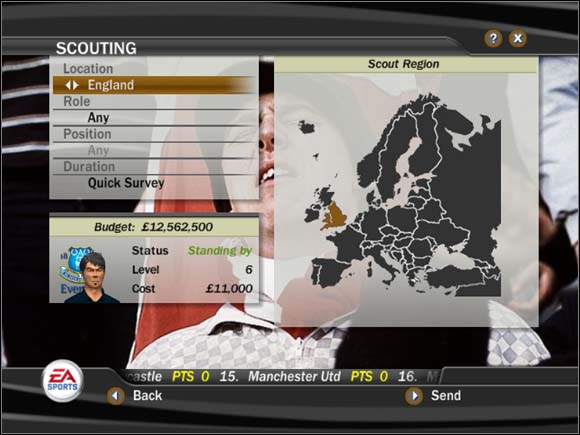
Location - here, we choose the region of our searches;
Role - who are we looking for? Striker, defender, midfielder? This is the place to specify it;
Position - now, we're giving details about player's position (left wing, right wing, etc.);
Duration - remember that the longer the scouting is, the more matches we have to play before our scout returns. Of course, longer duration means more precise search;
During changing scouting criteria, observe the cost of the expedition. Unfortunately, it is possible that although the salary is extremely high, our scout will return with nothing.
Youth academy
Youth academy gathers young people, who want to be professional footballers in the future. From time to time, somebody leaves the youth academy and tries to join your squad. This is the second way of acquiring young players.

They're, of course, beginners. They haven't got experience, but on the other hand, their salary is quite low. Press Offer Contract in order to incorporate a player into the team.
Contracts
Sometimes, we'll have to raise the salary of our players. I think it's obvious, but let's make it clear: if you pay them more, they'll try to play better.
Now, let's check the Player Contracts menu. Here, we can see the conditions of agreements we made with our men. If you want to renew a contract, select a particular player and press Renew Contract.
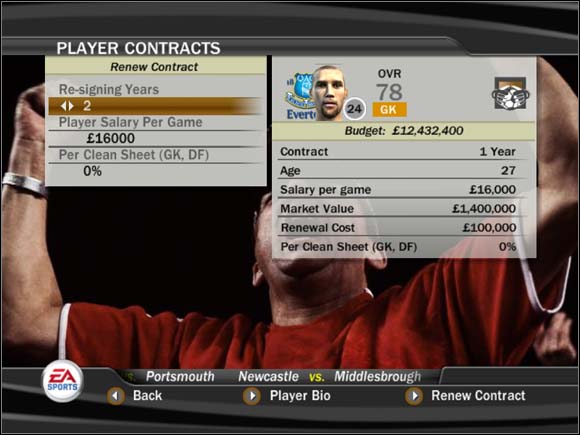
Take a look at the picture above, at the list located on the left. Starting from the top, we've got re-signing years, salary per game and additional bonus paid for an outstanding performance in the match (clean sheet).
Now let's check the right column. There, we can see, how long the current contract will remain, its terms and Renewal Cost. It's not a small value, so if you want to renew an agreement, think twice before you set the new conditions. Note, that player can always reject your offer.
Next thing worth keeping in mind is that if you have few players (minimum 18 players + 1 goalkeeper) and one of them will retire (34 years), your team won't be able to play in a match because of incomplete squad, and that means a walk-over. So keep an eye on contracts and terms of expiry. Search for new players before the older ones retire. That'll help you avoid loses at the beginning of a new season.
If a certain contract expires soon, we'll receive a admonition. We can also check such agreements in Contract Alerts menu.
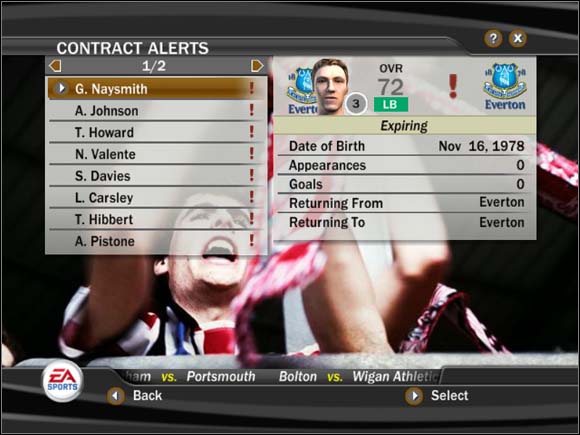
Experience
As you probably know, players gain experience during matches. We can make it faster by hiring new coaches and upgrading Medical Staff (Staff Upgrades). Raising salary helps too. Remember that our men have got morale - the higher it is, the better they play and try to score high. Morale raises when a footballer often plays on the pitch.
On the other hand, it is possible that always-substitute players may lose their football abilities. If you want to check, how footballers' experience will shape in future, open Player Growth menu.
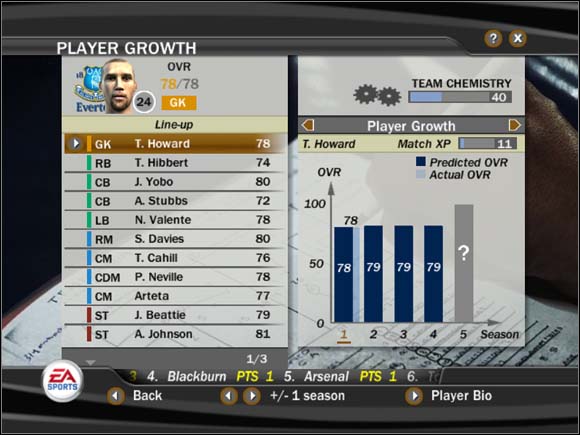
The bar chart on the right shows, how advanced player's abilities will be in the next seasons. In our example, overall estimation (OVR) of our footballer will oscillate around 79 points. The chart may change during the game if we, for example, won't let him play in next few matches. Remember also, that sometimes the chart will stay constant or even show a decline if the player is planning to retire (remember, he must be 34 years old).
The same bar charts are made for youth academy, but here in the timeline we've got years, not seasons.
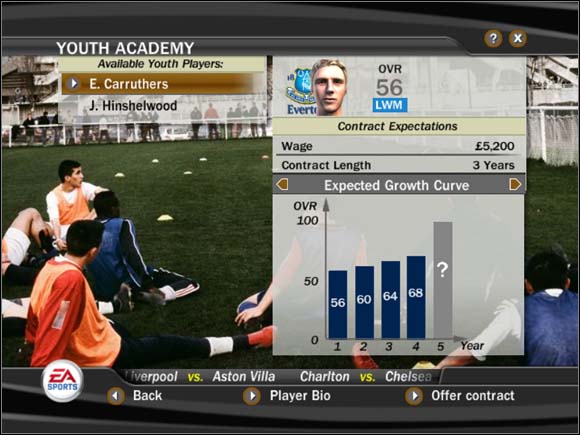
After a match, we can check, how experience of our men raises.
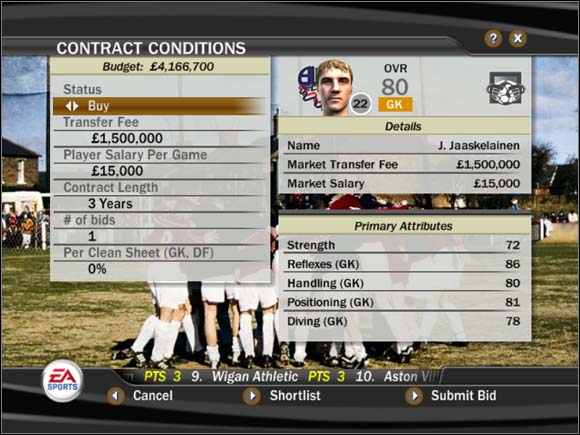
If we want to buy or loan a particular player, we have to wait for the transfer period. When it comes, check the Transfers menu.
Buy/loan a player
In this Transfers menu, we've got Transfer Market option, where we can buy or loan a footballer.
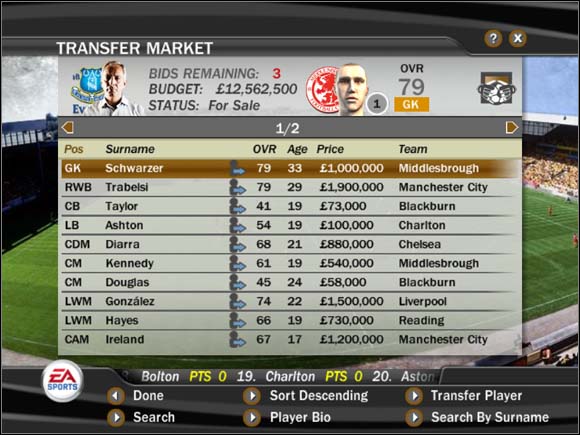
As you can see in the picture above, there's a grey symbol with a coloured arrow next to player's surname. If the arrow is blue, that means the footballer can be bought. A yellow one means that the we can loan the player. If nobody from the list interests us, we can use Search and Search by Surname options to find a required player.
Let's say we found a interesting one. Now, it's time to make an offer.

Sometimes it is really difficult to negotiate good terms of contract. First of all, make sure you've got an experienced negotiator (check In the club chapter).
Let's start from the top:
Status - here, we state if we want to buy or loan a player;
Transfer Fee - once-paid fee for the transfer;
Player Salary Per Game - the most important thing. The money you pay to your footballers is the biggest liability for the club, so try to negotiate the lowest salary you can;
Contract Length - here, we determine, how long the contract will remain in force;
# of bids - now, we have to determine, how much offers we'll give in order to reach an agreement;
Per Clean Sheet - additional bonus paid for an outstanding performance in the match (clean sheet).
A good offer characterizes by low salary per game. This can be done by paying bigger transfer fee. And don't become discouraged if player (and the club in which he plays) rejects your offer.
Sell/loan a player
Sell or let other clubs use your men in order to minimise your club's salary cost. How?
Open Club Transfer List in the Transfers menu.
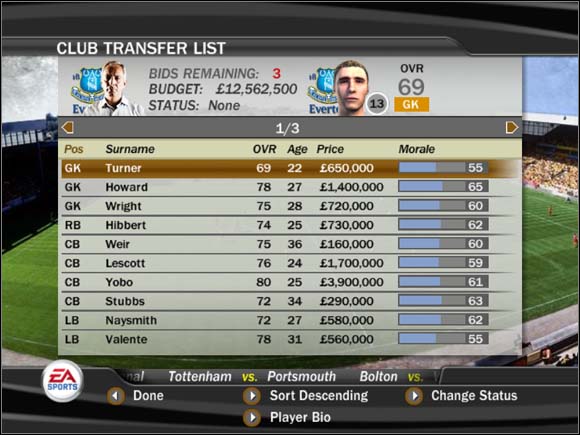
A list of our players will appear. If we want to sell or loan someone, we choose a particular footballer, press Change Status and simply set the status. After a match, someone will probably make an offer.
Financial prediction
Let's check the Financial Predictions section, in Office menu.
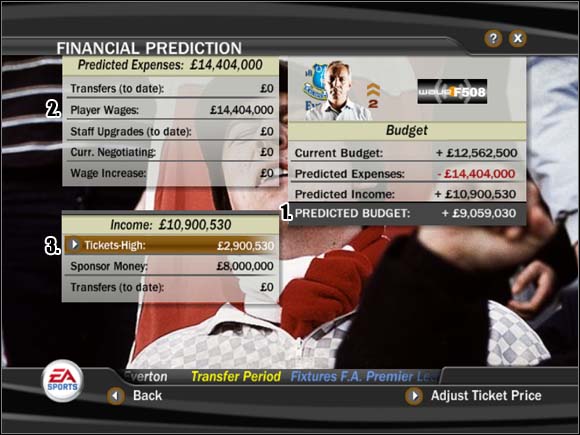
1. In the Budget section, we've got predictions that refers to balance of club's account after a certain period of time. Of course, it is always better when Predicted Income is higher than Predicted Expenses;
2. Player Wages are the biggest financial problem in Manager Mode. Always try to minimise it;
3. Here, we set the price of the tickets sold in our stadium. Remember, that if fan support is high, people will be willing to pay more in order to see your team in action live.
Summary
After each match, we can see a summary of our budget.
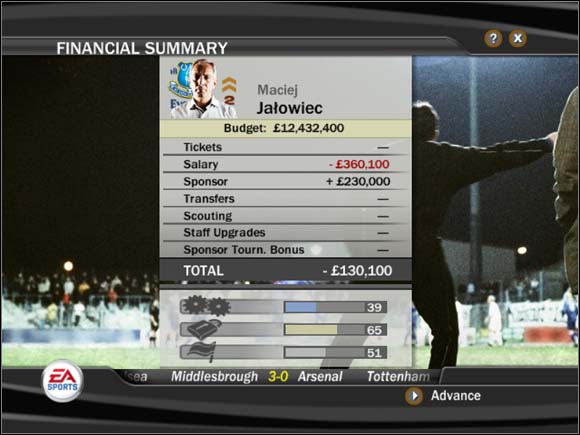
As we can see in the picture above, salary took more money than the sponsor gave to us. Note, that there's no ticket income. That's because this match wasn't played on our stadium.
Also, pay attention to stripes located in the bottom of the picture. After each match, team chemistry, job security and fan support change and these stripes indicate it.
Formation
Team Management menu is composed, among others, of a Squad option. That's where we can change the team's formation.
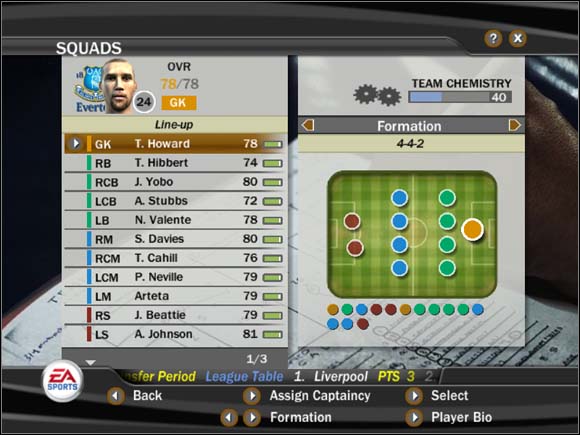
We use two buttons in the bottom of the screen (< and >) to change the formation. Get familiar with abilities of your men and try to choose a good one. If there are fast midfielders and tall forwarders in your team, it would be a good idea to play on the wings. Footballers who have high accuracy, should be placed in the middle. In that case, use short passes and through balls to get closer to the rival's goal.
Kick takers
Kick Takers option in the Team Management menu allows us to set, who has to perform corners, free kicks and penalties.
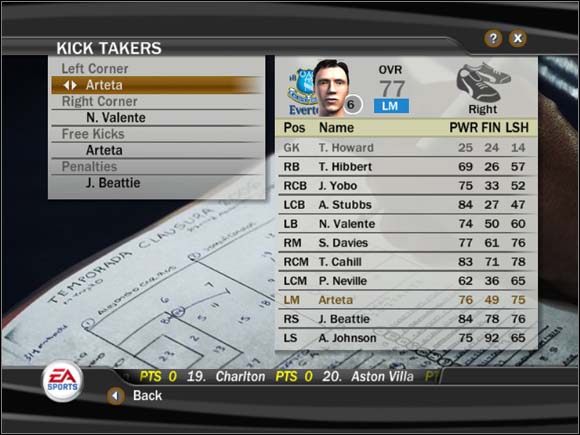
Let's start from the top: corners should be performed by these, who have high accuracy. It is also helpful when the left corner is assigned to a player, who prefers right foot and the right corner should be performed by a footballer, who likes left foot.
Free kicks are based on accuracy too, so check who has got a high one. It is written in players' bios.
Penalties can be performed, in principle, by everyone, but it wouldn't be a bad thing if the shooter has high accuracy.
This is the second part of the game guide and it concerns on various manoeuvres that can (or has to) be done during a match, if necessary. But first of all, I advice you to choose the button configuration. There are two types of them - classic and new - and we must decide, which one we'll use. List below shows what particular keys do (more details about button configuration are associated with specific manoeuvres):
Classic:
[A] - cross / long pass / sliding tackle;
[S] - switch player / pass;
[D] - shot on target / conservative tackle;
[W] - through ball / goalkeeper charge;
[E] - sprint.
New:
[A] - shot on target / clearance / call second defender;
[S] - pass / conservative tackle;
[D] - cross / long pass / sliding tackle;
[W] - through ball / goalkeeper charge;
[E] - sprint;
[Q] - trigger run / tactic modifier / switch player.
Mastering dribbling makes your rival's life much more difficult. Good dribbling abilities allow to control the ball and hold the possession. Here are a few tricks:
Sprint (button [E]) may be quicker if you let the ball roll faster by pressing [Shift]. Note that it may be a little bit risky, because it may lead to possession loss.
![Slowing the pace can be done by pressing [C] - Dribbling - Movement on the pitch - FIFA 07 - Game Guide and Walkthrough](https://game.lhg100.com/Article/UploadFiles/201512/2015121519012899.jpg)
Slowing the pace can be done by pressing [C]. Player will walk very slowly with the ball, in the chosen direction.
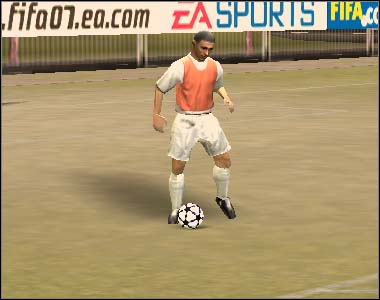
Crosses allows the player to move the action from a wing right into the rival's box. It is an important manoeuvre and there are a few kinds of it.
We perform the easiest one by pressing button [A] (new configuration - button [D]). Footballer will kick the ball high and the distance of the cross depends on how long we hold the key responsible for performing this manoeuvre.
![Double-clicking [A] (or [D], if we use new configuration) leads to a typical pass - the ball rolls on the pitch, right into the box - Crosses - Movement on the pitch - FIFA 07 - Game Guide and Walkthrough](https://game.lhg100.com/Article/UploadFiles/201512/2015121519012851.jpg)
Double-clicking [A] (or [D], if we use new configuration) leads to a typical pass - the ball rolls on the pitch, right into the box.

If your rival has the possession, try to control these players who are close to the ball. Switch your men by pressing [S] (the same button for both configurations).
When you get close to the rival with the ball, we can simply run onto him and regain possession. But if the opposite team has experienced players, press [D] (new configuration - [S]) while physical contact to take the ball away from the opponent.
![Holding [D] (or [S], in new configuration) results in a conservative tackle - Defence and fouls - Movement on the pitch - FIFA 07 - Game Guide and Walkthrough](https://game.lhg100.com/Article/UploadFiles/201512/2015121519012844.jpg)
Holding [D] (or [S], in new configuration) results in a conservative tackle. Thanks to that, rival with the ball has limited options of moving and performing a pass.
![If an opponent player gets close to our goal, press [W] to perform a goalkeeper charge - Defence and fouls - Movement on the pitch - FIFA 07 - Game Guide and Walkthrough](https://game.lhg100.com/Article/UploadFiles/201512/2015121519012847.jpg)
If an opponent player gets close to our goal, press [W] to perform a goalkeeper charge. This makes shooting on target much more difficult.
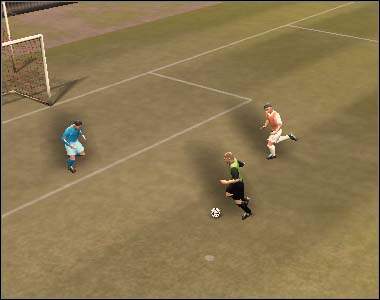
Fouls are one of the ways to defend the goal too. There are two types of them. The first one consists on a push that is being performed automatically if you run onto rival's heels.
![The second kind is a traditional sliding tackle, which can be performed by pressing [A] (new configuration - [D]) - Defence and fouls - Movement on the pitch - FIFA 07 - Game Guide and Walkthrough](https://game.lhg100.com/Article/UploadFiles/201512/2015121519012907.jpg)
The second kind is a traditional sliding tackle, which can be performed by pressing [A] (new configuration - [D]).
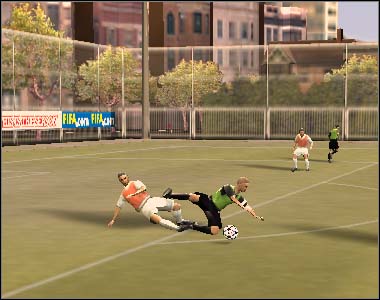
Note that such tackles often ends with yellow and red cards. Sometimes, however, referee gives an advantage - that means, we won't be punished for a foul if:
Pass is a really basic manoeuvre in football. Getting familiar with it gives a real advantage during the match, which, of course, results in more goals.
The easiest pass can be performed by pressing [S]. The player we actually control (and who has got the ball, of course) passes the ball to this footballer, in which direction he actually looks.
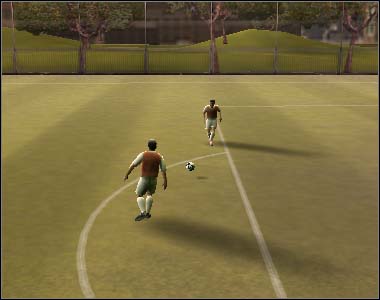
There's also an "pass & run" combination. After performing a pass, player starts to run towards rival's goal. This manoeuvre is quite useful while making a way through rival's defence, but it can be replaced with several passes as well. Press [Q] + [S] buttons to perform it.
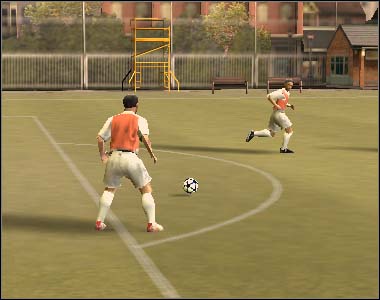
Long passes could be useful in the same situations as the one described above. Furthermore, long passes allows to move the action from one point of the pitch to another really fast. Although these passes are quite accurate, the ball flies a bit low and somebody can intercept it. Press [A] (new configuration - [D]) to perform it.
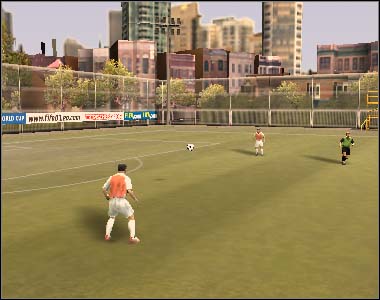
It is also possible to simulate collecting a pass by letting the ball roll between player's legs. Hold [Z] before your footballer collects the pass. But before this action, make sure that you won't lose possession after this manoeuvre.
![If we press [Z] in the same situation as presented above, footballer will let the ball roll next to his feet - Passes - Movement on the pitch - FIFA 07 - Game Guide and Walkthrough](https://game.lhg100.com/Article/UploadFiles/201512/2015121519012966.jpg)
If we press [Z] in the same situation as presented above, footballer will let the ball roll next to his feet. After that, he'll get to the ball and continue the run along the pass' route.
![Press [Q] button to trigger run - Passes - Movement on the pitch - FIFA 07 - Game Guide and Walkthrough](https://game.lhg100.com/Article/UploadFiles/201512/2015121519012902.jpg)
Press [Q] button to trigger run. It works with the player you actually look at with other footballer. He'll simply run towards rival's goal if trigger run key is pressed.

Press [D] (new configuration - [A]) to perform a shot on target. The longer you hold the button, the stronger the shot will be. Of, course, if you're far from rival's goal, more power is necessary. Note, that the ball flies high after a strong shot, so there is a possibility of a miss, even if the shooter is standing a few meters from the goal.
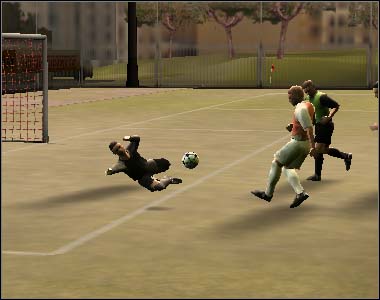
If rival goalkeeper often performs charges, try to kick the ball over him. This can be done by pressing [Q] + [D] (or [Q] + [A], if new configuration is in use).
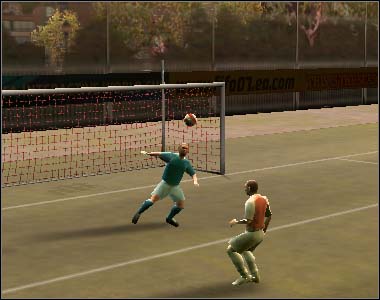
During the match, various tactic settings are possible. To make that kind of changes, use your numerical keyboard.
First menu refers to offensive play:
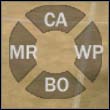
The second menu refers to the defence:
![We can also set a general team's attitude by pressing [5] on numerical keyboard - Tactic - Movement on the pitch - FIFA 07 - Game Guide and Walkthrough](https://game.lhg100.com/Article/UploadFiles/201512/2015121519013094.jpg)
We can also set a general team's attitude by pressing [5] on numerical keyboard.
The red triangle symbolises offensive play.
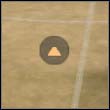
And the green one - defensive play.
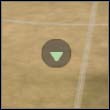
Free kicks
Free kicks can be divided into two groups - indirect and direct. We'll take a look at the indirect ones first.
The most important thing that characterizes indirect free kicks is the fact, that it is impossible to score a goal from it. They can be only used to gain possession and, after that, continue a normal game.
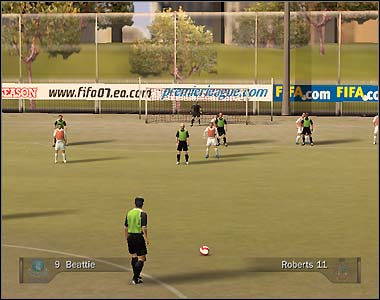
Although direct free kicks gives the chance to beat the goalkeeper and score a goal or perform a cross, rival players always form a wall in order to block the shot. We can also press [8] to call second player.
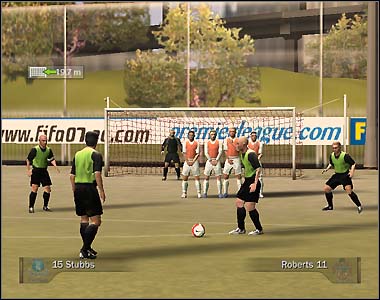
Corner kicks
Corners are quite easy. First of all, use arrows on the keyboard to set the direction of the shot. Then, we have decide, what kind of shot we want to perform. Press [S] to pass the ball to the closest colleague. Use buttons [A] or [D] to perform a typical cross.
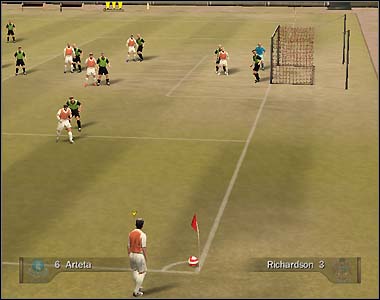
If you want to cross the ball, you must know how much power the shot requires. A power bar appears in the screen in the beginning of the shot. Optimal power is presented in the picture below (white stripe).

Twisting the ball
While performing free kicks, corners and even crosses, we can twist the ball's trajectory. To do it, hold left or right arrow on keyboard (according to the direction in which you want to send the ball) right before the shot. The radius of curve the ball passes depends (mainly) on shooter's abilities. Ronaldinho, for example, is a good player, so his twisted passes have got shorter radius and, in addition, are more accurate than these of, let's say, Michael Essien.
Penalties
Press [D] (new configuration - [A]) to perform a penalty shot. It is also possible to change the direction of the shot by pressing left or right arrow on the keyboard. It may increase the probability of scoring a goal. However, if you hold an arrow for too long, the ball will hit the post or even miss the goal.
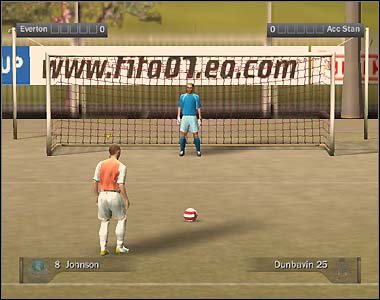
If you're playing as a goalkeeper, use arrows to choose, in which direction the goalkeeper has to dash.
Cross is one of the tactic that allows to score a goal. In previous FIFA games, crosses almost always guaranteed a score. Here, it isn't a walk in the park (finally!), nevertheless, good wing play is just another advantage of a team.
Crosses requires midfielders (or even defenders) on the wings of the pitch. Formation presented below fulfils this necessity.
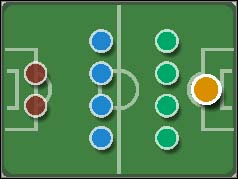
First of all, midfielder on the wing has to have the ball. If it is done, he's going along the side line, towards rival's box.
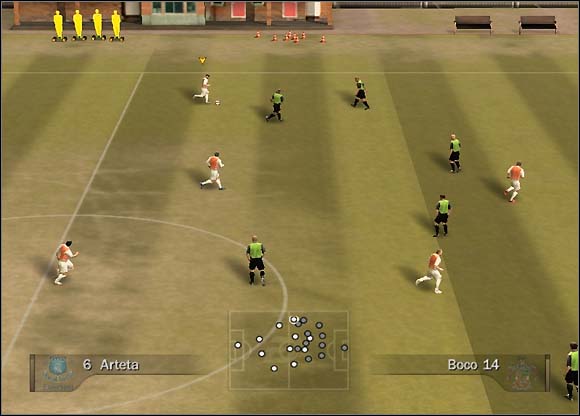
If rivals will try to regain possession, pass the ball to the nearest friendly footballer.
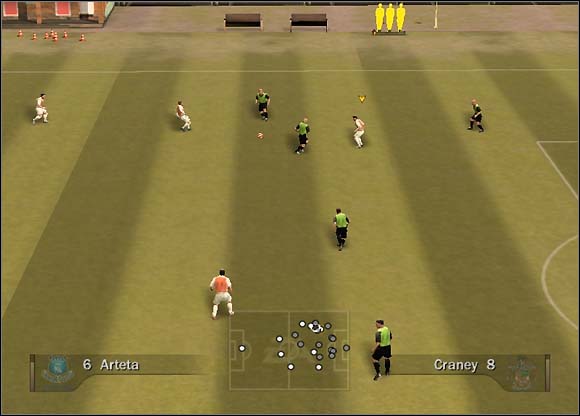
When you get next to the box with the ball, perform a cross. I advise you to kick the ball high instead of making a traditional pass on the surface of the pitch. The second option has sense when there's few rival players in the box. You can also twist the ball's flight.
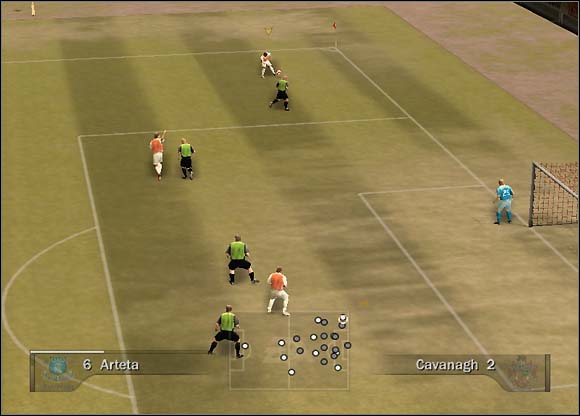
![If the cross is accurate and one of your strikers collects the ball, make a shot on target by pressing [D] or - if you use new configuration - [A] - Wing play, crosses - Tactical solutions and tips - FIFA 07 - Game Guide and Walkthrough](https://game.lhg100.com/Article/UploadFiles/201512/2015121519013171.jpg)
If the cross is accurate and one of your strikers collects the ball, make a shot on target by pressing [D] or - if you use new configuration - [A]. Moreover, kicking the ball over the goalkeeper by pressing [Q] +[D]/[A] is also available.
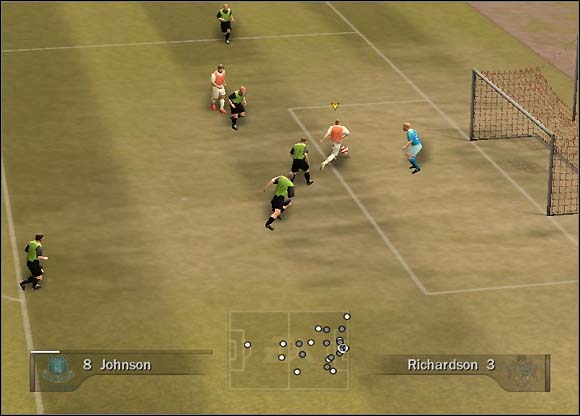
Using through balls also helps in scoring goals, sometimes it's even better than crosses. This element of the game is quite difficult, but mastering it is a great advantage.
Protruding strikers are a necessity if you want to perform a through ball. Picture below shows a matching formation.
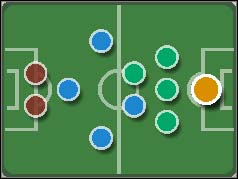
At the beginning, one of your midfielders has to have the ball.
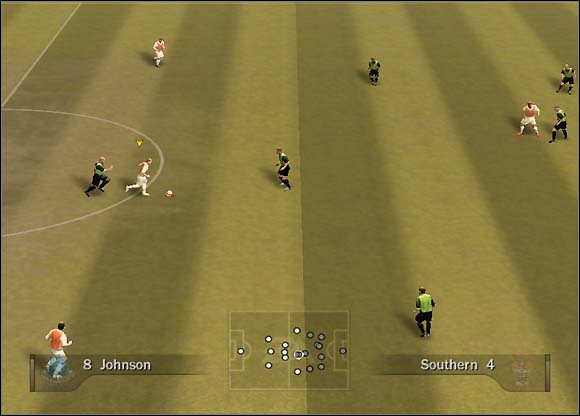
This midfielder starts to run in the middle of the pitch, towards rival's goal. If one of our forwarders will stand in one line with the last opponent defender (excluding goalkeeper), perform a through ball to him by pressing button [W] or [Q] + [W] for a long pass. And one more thing - beware of offside traps!

After the through ball, forwarder starts to run towards rival's goal. It is a necessity to keep a distance from opponent defenders. In order to keep it, press [E] to sprint. Another way to do it is zigzag.
![The goalkeeper will probably charge, so press [Q] + [D] (new configuration: [Q] + [A]) to kick the ball over him - Through balls - Tactical solutions and tips - FIFA 07 - Game Guide and Walkthrough](https://game.lhg100.com/Article/UploadFiles/201512/2015121519013292.jpg)
The goalkeeper will probably charge, so press [Q] + [D] (new configuration: [Q] + [A]) to kick the ball over him. If he won't, you may ignore the [Q] button and make a normal shot on target.
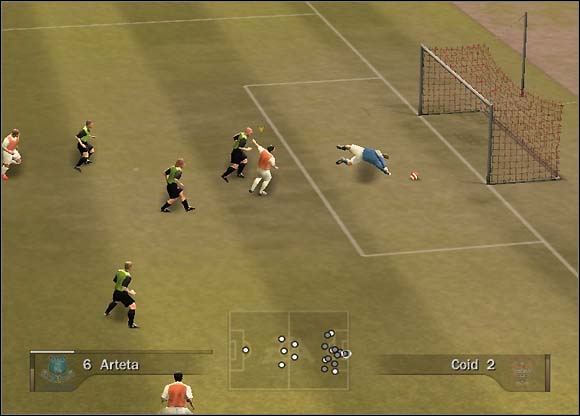
Shots on target from a longer distance mainly requires reflex. It is useful in setting a proper shot strength. It shouldn't be too weak, because such shots are easy to stop. On the other hand, lot of power makes the shot really inaccurate. Press [D] (new button configuration - [A]) to shoot.
Prepare for a shot when only the goalkeeper stands between you and the goal. Of course, shooting from a further distance could have an awesome effect too, but there's a risk that one of the defenders will block the shot with his own body. The longest distance from which scoring a goal is quite probable is 4-5 meters before the box (see picture below).
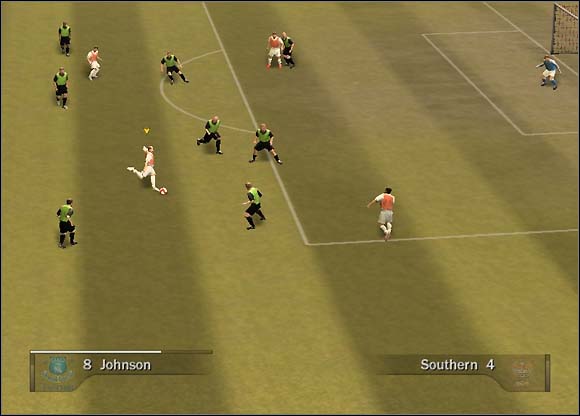
Throw-in itself gives the possession only, nothing else.
The most important thing is what we'll be able to do AFTER the throw. In most cases, it depends on the place where the throw-in takes place. Take a look at the picture below - if the action takes place near rival's box, an immediate cross is possible.
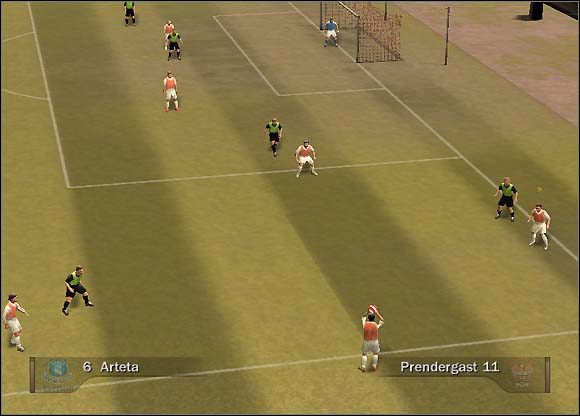
Two buttons are used for throws-in:
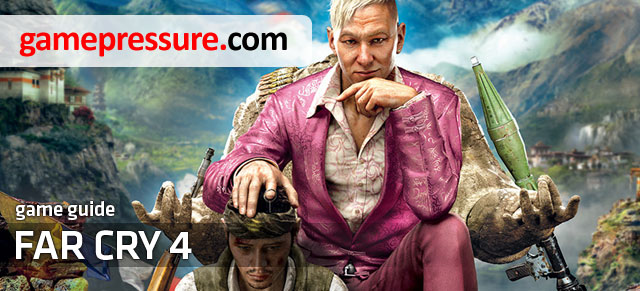
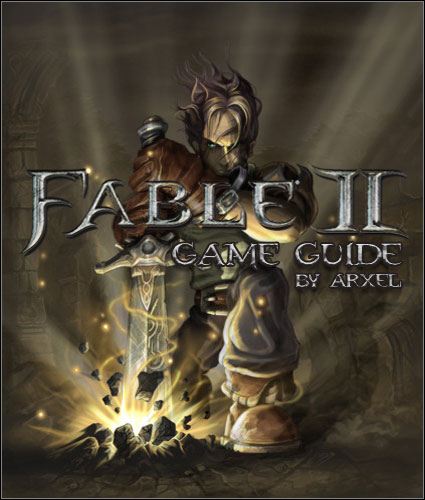

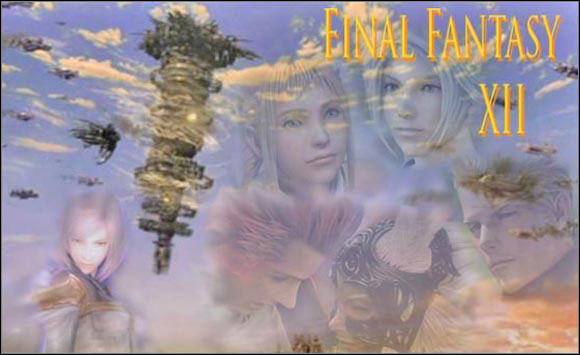
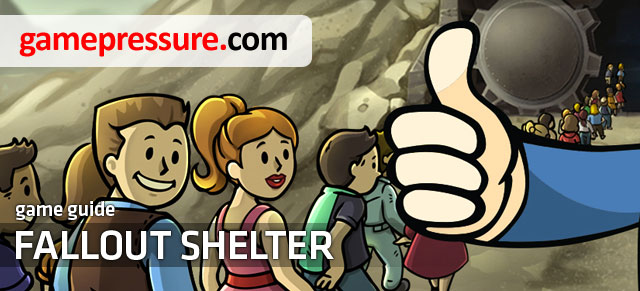 Fallout Shelter Game Guide & Walkthrough
Fallout Shelter Game Guide & Walkthrough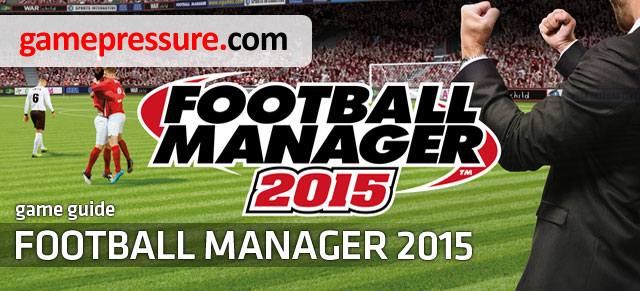 Football Manager 2015 Game Guide & Walkthrough
Football Manager 2015 Game Guide & Walkthrough Fallout 3: Operation Anchorage Game Guide & Walkthrough
Fallout 3: Operation Anchorage Game Guide & Walkthrough Far Cry 2 Game Guide & Walkthrough
Far Cry 2 Game Guide & Walkthrough Fallout 3: Broken Steel Game Guide & Walkthrough
Fallout 3: Broken Steel Game Guide & Walkthrough